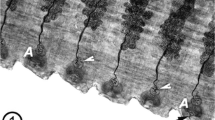Summary
Previous investigators have reported that albuminous material in the albumin-secreting (tubular gland) cells of the magnum of hen oviduct accumulates in the ergastoplasmic cisternae and is released directly into the glandular lumen without being first concentrated into secretory granules in the Golgi region (Zeigel and Dalton, 1962). Present fine structural studies on the tubular gland cells in oviducts from actively laying wild-type Japanese quail and in an oviduct from an actively laying hen indicate that the Golgi apparatus is directly involved in the formation of secretory granules. At least three types of granules can be observed in the tubular gland cells at various times, and all types seem to be associated initially with the Golgi apparatus.
In actively laying quail, the distribution of electron opaque, intermediate, and light granules within the superficial and deep regions of the glandular epithelium varies, depending on the presence of an egg in a particular region of the oviduct. Secretion of the product is merocrine, involving fusion of granule membranes with the plasmalemma of the cell surface.
Granules first appear in the tubular gland cells of quail oviducts at about 4 1/2 weeks of age. The granules are of the electron opaque type and probably represent secretion in concentrated storage form. At this age, a few of the tubular gland cells exhibit distended ergastoplasmic cisternae containing material of low electron density. The appearance of these “light” cells, which occur with greater frequency in oviducts from older quail, probably reflects an increased level of secretory activity initiated by changes in hormonal levels. From 5 weeks of age on, intermediate and light (less concentrated) granules, as well as dark granules, are present.
Similar content being viewed by others
References
Aitken, R. C. N., Johnston, H. S.: Observations on the fine structure of the infundibulum of the avian oviduct. J. Anat. (Lond.) 97, 87–99 (1963).
Carey, N. H.: The mechanisms of protein synthesis in hen oviduct. In: Physiology of the domestic fowl. British Egg Marketing Board Symposium, Number One (C. Horton-Smith and E. C. Amoroso, eds.), p. 125–132. London: Oliver and Boyd 1965.
Caro, L. G., Palade, G. E.: Protein synthesis, storage, and discharge in the pancreatic exocrine cell. An autoradiographic study. J. Cell Biol. 20, 473–495 (1964).
Fertuck, H. C.: Fine structural studies on the albumin-secreting cells in quail and hen oviducts. Can. Fed. Biol. Soc. Proc. 12, 38 (1969) (abstr.).
Hendler, R. W.: Isolation of “lipopeptides” from hen oviduct. Biochim. biophys. Acta (Amst.) 74, 659–666 (1963 a).
—: Metabolic properties of “lipopeptides” isolated from hen oviduct. Biochim. biophys. Acta (Amst.) 74, 667–677 (1963 b).
—: Uptake of nucleic acid, protein and carbohydrate precursors by hen oviduct lipids. Biochim. biophys. Acta (Amst.) 106, 184–196 (1964).
—: Lipoamino acids as precursors in the synthesis of authentic proteins by homogenates of hen oviduct. Proc. nat. Acad. Sci. (Wash.) 54, 1233–1240 (1965).
—, Dalton, A. J., Glenner, G. G.: A cytological study of the albumin-secreting cells of the hen oviduct. J. biophys. biochem. Cytol. 3, 325–330 (1957).
Horwitz, A. L., Dorfman, A.: Subcellular sites for synthesis of chondromucoprotein of cartilage. J. Cell Biol. 38, 358–368 (1968).
Jamieson, J. D., Palade, G. E.: Intracellular transport of secretory proteins in the pancreatic exocrine cell. J. Cell Biol. 34, 557–615 (1967).
Kohler, P. O., Grimley, P. M., O'Malley, B. W.: Protein synthesis: differential stimulation of cell-specific proteins in epithelial cells of the chick oviduct. Science 160, 86–87 (1968).
—: Estrogen-induced cytodifferentiation of the ovalbumin-secreting glands of the chick oviduct J. Cell Biol. 40, 8–27 (1969).
Lane, N. L., Caro, L., Otero-Vilardebo, L. R., Godman, G. C.: On the site of sulfation in colonic goblet cells, J. Cell Biol. 21, 339–351 (1964).
Luft, J. H.: Improvements in epoxy resin embedding methods. J. biophys. biochem. Cytol. 9, 409–414 (1961).
Neutra, M., Leblond, C. P.: Synthesis of the complex carbohydrate of mucus in the Golgi complex as shown by electron microscope radioautography of goblet cells from rats injected with glucose-H3. J. Cell Biol. 30, 119–150 (1966).
Oka, T., Schimke, R. T.: Interaction of estrogen and progesterone in chick oviduct development I. Antagonistic effect of progesterone on estrogen-induced proliferation and differentiation of tubular gland cells. J. Cell Biol. 41, 816–831 (1969).
Palade, G. E.: Functional changes in the structure of cell components. In: Subcellular particles (T. Hayashi, ed.), p. 64–83. New York: Ronald Press 1959.
Pearse, A. G. E.: Histochemistry, theoretical and applied, 2nd ed. London: J. and A. Churchill Ltd. 1960.
Reynolds, E. S.: The use of lead citrate at high pH as an electron opaque stain in electron microscopy. J. Cell Biol. 17, 208–212 (1963).
Richardson, K. C.: V — The secretory phenomena in the oviduct of the fowl, including the process of shell formation examined by the mioroincineration technique. Phil. Trans. B 225, 149–195 (1935).
—, Jarett, L., Finke, E. N.: Embedding in epoxy resins for ultra thin sectioning in electron microscopy. Stain Technol. 35, 313–323 (1960).
Romanoff, A. L., Romanoff, A. J.: The avian egg, 2nd ed. New York: John Wiley & Sons Inc. 1963.
Sabatini, D. D., Bensch, K., Barrnett, R. J.: Cytochemistry and electron microscopy. The preservation of cellular ultrastructure and enzymatic activity by aldehyde fixation. J. Cell Biol. 17, 19–58 (1963).
Watson, J. D., Crick, F. H. C.: Molecular structure of nucleic acids. A structure for deoxyribose nucleic acid. Nature (Lond.) 171, 737–738 (1953).
Wyburn, G. M., Johnston, H. S., Draper, M. H.: The magnum of the hen's oviduct as a protein secreting organ. Anat. Soc. Gr. Brit. and Ireland Summer Meeting (1969) (abstr.).
Zeigel, R. F., Dalton, A. J.: Speculations based on the morphology of the Golgi systems in several types of protein-secreting cells. J. Cell Biol. 15, 45–54 (1962).
Author information
Authors and Affiliations
Additional information
Supported by the National and Medical Research Councils of Canada.
Rights and permissions
About this article
Cite this article
Fertuck, H.C., Newstead, J.D. Fine structural observations on magnum mucosa in quail and hen oviducts. Z. Zellforsch. 103, 447–459 (1970). https://doi.org/10.1007/BF00337520
Received:
Issue Date:
DOI: https://doi.org/10.1007/BF00337520




